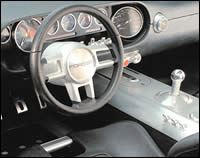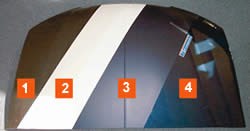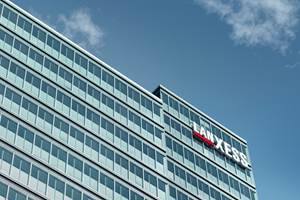Lightweight TP Composite Takes the Driver's Seat
A lightweight version of Azdel glass-reinforced polypropylene sheet is gaining ground in a host of new automotive applications.
A lightweight version of Azdel glass-reinforced polypropylene sheet is gaining ground in a host of new automotive applications. Already established in interior headliners, parcel shelves, and sun shades, Azdel SuperLite sheet is now being used for the first time in in door panels, instrument panels, upper and lower A and B pillars, console skirts, and other soft trim for a Ford Motor Co. niche vehicle to appear in the U.S. this summer. In exterior panels, Azdel SuperLite is making inroads in Class A hoods and hatchback gates for British cars that will come out this year.
“It’s a great fit in programs for up to 75,000 units/yr,” says Ken Forden, president of Azdel Inc., a joint venture of GE Advanced Materials and PPG Industries. He says this lightweight sheet, which is formed by a low-pressure, “thermo-stamping” process, allows shorter delivery times and lower tool costs than metal stamping or SMC compression molding. New automotive applications plus growth in established uses prompted Azdel to boost capacity for SuperLite sheet by 50% at Lynchburg, Va., to 50 million lb/yr.
Azdel SuperLite is made in a slurry process comparable to paper making. It entangles 42% to 55% chopped long-glass fibers in an aerated PP matrix, reducing density to 0.3 to 0.8 g/cc and basis weight to 600 to 2000 g/m2, depending on glass content and sheet thickness. In comparison, classic Azdel GMT made with chopped or continuous glass mat has a density of 1.17 to 1.29 g/cc and basis weight of 4400 to 5470 g/m2 at comparable glass content.
The lightweight sheet has a high stiffness-to-weight ratio, good impact resistance over a wide temperature range, excellent sound-damping properties, and outstanding creep resistance. The coefficient of thermal expansion (CTE) is lower than aluminum’s and close to steel’s.
Expanding soft-touch role
Lear Corp., an automotive systems integrator, is using Ford’s GT program to demonstrate the lightweight sheet’s potential in interior soft-touch parts. The vehicle is an “icon” car that Ford is promoting for its 100th anniversary.
Jim Masters, Lear’s “executive champion” for the Ford GT program, expects it to drive growth of the lightweight composite in niche programs. “It was a calculated risk to use this composite for most of the Ford GT interior parts, including soft-touch ones, but the results beat our expectations,” declares Alex Zaguskin, Lear’s engineering manager. He says the program went from concept to production in less than a year. Weight savings are 15% to 30%. At the designated volume (4500 units over three years), tooling cost is about one-tenth that of the alternatives.
Zaguskin says the Azdel SuperLite parts are decorated mostly with laminated leather skins, except for the console skirts, which have soft PVC skins. Azdel can supply the sheet already laminated with fabric, nonwovens, film, foam, or other finishing materials.
Azdel’s Forden says SuperLite currently has a 15% share in U.S. headliners, which he believes is likely to grow to 40% in five years through replacement of polyurethane foam headliners. SuperLite headliners resist creasing, permitting assembly in fewer steps than PUR versions. Most of today’s SuperLite headliners incorporate PP foam, but one-piece designs that meet cushioning requirements are being developed.
Exterior panels break out
The first horizontal exterior automotive panel to utilize the lightweight sheet is a 9.9-lb, 2-ft-square hood for a British sports car whose projected annual volume is 15,000 units. The hoods are compression molded by BI Composites Ltd. in Cannock, U.K. SuperLite sheet forms the core of a three-layer hybrid structure that includes inner and outer skins with 60% continuous, unidirectional glass fibers. Derived from aerospace prepreg technology, the skins improve strength, creep resistance, and surface appearance. Azdel Inc. uses nip-roll lamination to adhere the skins to the SuperLite core. The result is a resin-rich surface able to hide the glass fibers and produce a Class A finish when painted.
“Our 2-mm-thick hybrid panel increases stiffness and reduces weight by 50% versus steel,” says Mike Birrell, BIC’s business-development director. He says the hybrid skins overcome the drawbacks of injection molding thermoplastic horizontal panels—low creep resistance and visibility of the embedded glass fibers that impairs a Class A finish. The hoods are painted off-line after flame-treating and application of a standard PP primer. They are then clear-coated for high gloss.
Hybrid hoods suffer less damage in impact testing and offer better energy absorption than steel—especially critical to meeting European pedestrian-impact requirements, Birrell says. The hoods’ CTE is uniform and close to steel’s, which makes gap expansion in adjoining panels controllable. Fast delivery and reduced tool cost ($88,000) yields 50% to 75% savings versus tooling for steel or SMC panels.
BI Composites’ hood design has been adopted for a second OEM’s 40,000-unit/yr program for a roadster. “It’s cost-effective versus steel for up to 100,000 units/yr,” claims Birrell. In a few years, he expects demand to blossom in roofs, fenders, and hatchback doors that are now steel or SMC.
BI Composites is also using its hybrid structure for non-appearance parts, notably hatchback door liners and under-hood engine covers for the 2004 model Renault Clio. Covers are molded in black; hatchback liners are black but fabric-decorated. Molded-in electrical wiring can be inserted under the skins of hybrid parts.
Expanding the envelope
Injection molded thermoplastics face major deficits in large, horizontal panels in terms of creep resistance and crash resistance, says Paul Bristow, Azdel’s commercial technology director. But he says those issues are addressed with SuperLite, opening up further potential in underbody shields, seats, load floors, and panels for cars and farm, construction, and recreational vehicles.
Azdel is exploring ways to extend the properties of SuperLite composite. One initiative is to replace PP with higher-performing materials. Azloy and Azmat families utilize amorphous (PC, PC/ABS, PC/PBT, and PEI) and semi-crystalline (PET) resins, respectively, to enhance strength and heat resistance. One motive is to allow exterior panels to survive on-line painting with steel.
Ultem SuperLite sheet exhibits excellent flame and smoke performance. It is said to have potential in large structural panels for trains and planes and backings for spas. Also being explored is eliminating paint by adhering decorative films to SuperLite sheets. Azdel Inc. is working with GE Advanced Materials in Pittsfield, Mass., to use GE’s new Lexan SLX PC-copolymer film as formed inserts for back-molding of SuperLite parts with a Class A decorative finish.
Azdel Inc. is investigating twin-sheet thermoforming of SuperLite. Bristow says twin-sheet forming would yield hollow parts amenable to integrated parts like instrument panels incorporating airbag systems and headliners incorporating audio and other entertainment devices.
Related Content
How to Optimize Injection Molding of PHA and PHA/PLA Blends
Here are processing guidelines aimed at both getting the PHA resin into the process without degrading it, and reducing residence time at melt temperatures.
Read MoreLanxess and DSM Engineering Materials Venture Launched as ‘Envalior’
This new global engineering materials contender combines Lanxess’ high-performance materials business with DSM’s engineering materials business.
Read MoreUnderstanding the ‘Science’ of Color
And as with all sciences, there are fundamentals that must be considered to do color right. Here’s a helpful start.
Read MoreMelt Flow Rate Testing–Part 1
Though often criticized, MFR is a very good gauge of the relative average molecular weight of the polymer. Since molecular weight (MW) is the driving force behind performance in polymers, it turns out to be a very useful number.
Read MoreRead Next
People 4.0 – How to Get Buy-In from Your Staff for Industry 4.0 Systems
Implementing a production monitoring system as the foundation of a ‘smart factory’ is about integrating people with new technology as much as it is about integrating machines and computers. Here are tips from a company that has gone through the process.
Read MoreUnderstanding Melting in Single-Screw Extruders
You can better visualize the melting process by “flipping” the observation point so that the barrel appears to be turning clockwise around a stationary screw.
Read MoreAdvanced Recycling: Beyond Pyrolysis
Consumer-product brand owners increasingly see advanced chemical recycling as a necessary complement to mechanical recycling if they are to meet ambitious goals for a circular economy in the next decade. Dozens of technology providers are developing new technologies to overcome the limitations of existing pyrolysis methods and to commercialize various alternative approaches to chemical recycling of plastics.
Read More































